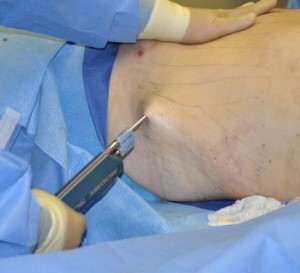Liposuction has been with us for over thirty years and it is relatively just as effective today as it has been in the past. While liposuction techniques and technology have improved, its basic principles of how it works have remained relatively constant. The workings of liposuction is much more that just ‘sticking a tube in and sucking it out’. If it were that simple, plastic surgeons would merely put a tube in you today and come back tomorrow and you would be really skinny.
In The Science of Liposuction Part 1, the importance of a pretreatment infusion of fluid (tumescence) was reviewed. In this article, a second important principle of liposuction is reviewed, the forces needed to extract the unwanted fat.

But how much suction force (negative vacuum pressure) is needed to pull fat out? It is generally accepted that the ideal amount of suction needed for liposuction is -20 cms of water or -1 atmosphere of pressure. (at room temperature the vapor pressure of water is roughly 20mm Hg) This will definitely pull dislodged fat and fluids through the attached tubing. Lesser amounts of negative pressure will also work just not as efficiently.
But suction also causes another important phenomenon…the vaporization of water. If you have ever witnessed an actual liposuction procedure, you may have occasionally seen bubbles in the fat or bubbling in the plastic cannister from time to time. From a pure physics standpoint, this is technically water boiling….or the vacuum pressure exceeding the vapor pressure of the water in the fat being removed. It is this vaporization that makes the viscosity of fat (how thick it is), which is actually a combination of fat, blood, and infiltration fluid, less to improve its ease of flow through the tubing. From a flow standpoint, water that is vaporized (a gas) flows 100 times faster than liquid water. In essence an inadvertent but important effect that suction has is to ‘liquify’ the fat and to some degree ‘gasify’ it to make its removal easier. This also explains why liposuction done at higher altitudes, where the water vapor of pressure is less, is somewhat easier to do. (takes less suction pressure from the machine)
No one has yet come up with how to turn fat completely into a gas in the extraction process (without heating it), but when they do liposuction will be a far more efficient and effective treatment.
Dr. Barry Eppley
Indianapolis, Indiana


